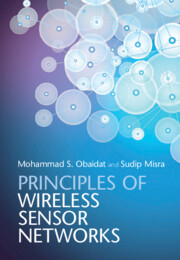Book contents
- Frontmatter
- Dedication
- Contents
- Preface
- 1 Introduction to wireless sensor networks
- 2 Inside a wireless sensor node: structure and operations
- 3 Wireless sensor network applications: overview and case studies
- 4 Medium access in wireless sensor networks
- 5 Routing in wireless sensor networks
- 6 Transport protocols for wireless sensor networks
- 7 Localization and tracking
- 8 Topology management and control
- 9 Performance evaluation of wireless sensor networks
- 10 Security issues in wireless sensor networks
- 11 Wireless mobile sensor networks
- 12 Wireless multimedia sensor networks
- 13 Underwater sensor networks
- 14 Wireless underground sensor networks
- References
- Subject index
- References
14 - Wireless underground sensor networks
Published online by Cambridge University Press: 05 December 2014
- Frontmatter
- Dedication
- Contents
- Preface
- 1 Introduction to wireless sensor networks
- 2 Inside a wireless sensor node: structure and operations
- 3 Wireless sensor network applications: overview and case studies
- 4 Medium access in wireless sensor networks
- 5 Routing in wireless sensor networks
- 6 Transport protocols for wireless sensor networks
- 7 Localization and tracking
- 8 Topology management and control
- 9 Performance evaluation of wireless sensor networks
- 10 Security issues in wireless sensor networks
- 11 Wireless mobile sensor networks
- 12 Wireless multimedia sensor networks
- 13 Underwater sensor networks
- 14 Wireless underground sensor networks
- References
- Subject index
- References
Summary
Wireless sensor networks (WSNs), due to their unique features such as fault tolerance, scalability, low production cost, and secured transmission, have found applications over widespread domains. Underground sensor networks have their constituent sensor nodes deployed underground, and are designed to operate underneath the earth’s surface. Each of these nodes is equipped with a processor, a finite local storage memory, a radio, an antenna, and a power source unit. Underground sensor networks can be broadly classified into two categories, based on their data dissemination modes, namely, wired underground sensor networks, and wireless underground sensor networks (WUGSNs) [1–3]. Wired underground sensor networks [1–19] are composed of sensing devices, a small processor, limited memory, an antenna, and a power source. These devices are connected to data loggers on the surface by using wires. Data loggers act as transceivers between the sensors and the central data sink. At the receiver end, the data loggers receive and store data that are disseminated from the underground sensor devices. These data are then transmitted to a central data sink or network administrator site by the data loggers for further interpretation and analysis. On the other hand, WUGSNs consist of multiple wireless sensor nodes, each having a sensing unit, a local processing unit, a local storage memory, a radio, an antenna, and a constant source of power. Each of these nodes is capable of acting independently for transmitting the sensed data to the data sink. The nodes establish a multi-hop wireless communication network to ensure reliable and secured dissemination of sensed data.
The general applications of WUGSNs involve real-time soil monitoring in agricultural applications, measuring toxicity of soil for environment monitoring, infrastructure monitoring, underground mine detection, and border surveillance [1–3]. A WUGSN can effectively replace a traditional wired underground sensor network, as it overcomes most of the shortcomings of its wired counterpart. Unlike wired underground sensor networks [2], WUGSNs do not require concealment of sensing devices in order to protect them from environmental hazards, theft, and other issues of insecurity. WUGSNs are easy to deploy, and are cost effective in comparison to wired underground sensor networks. Moreover, WUGSNs are able to disseminate real-time data with higher reliability and security. Coverage density of WUGSN is also comparatively high, and any failure in a WUGSN can be detected with ease. Owing to these unequivocal advantages, WUGSNs can efficiently replace the wired underground sensor networks in most of their fields of applications. In this chapter, we focus on WUGSNs and their design, architecture, and application areas.
- Type
- Chapter
- Information
- Principles of Wireless Sensor Networks , pp. 348 - 370Publisher: Cambridge University PressPrint publication year: 2014
References
- 1
- Cited by

